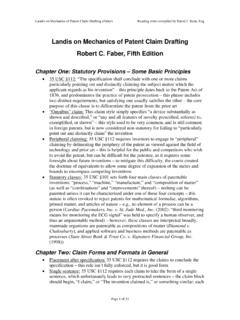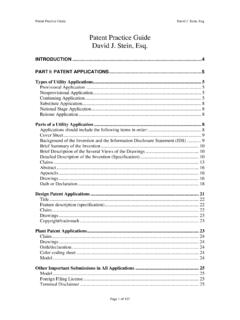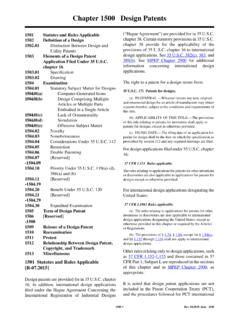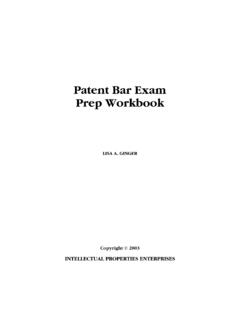Transcription of How to Write a Patent Application - djstein.com
1 How to Write a Patent Application (Sheldon) Reading notes compiled by David J. Stein, Esq. How to Write a Patent Application Jeffrey G. Sheldon Chapter One: Introduction and When to File Introduction: According to the Supreme Court, a Patent Application for an invention is one of the most difficult legal instruments to draw with accuracy . (Topliff v. Topliff (1892)) the drafting process involves describing the invention to those of ordinary skill in the art, and in terms a jury and judge would understand; teaching how to use it, and describing the best mode; claiming the invention broadly to prevent design-around efforts, but narrowly to avoid all prior art; complying with the requirements of the USPTO; and taking all steps necessary to achieve issuance of the Patent the skill in drafting patents is usually acquired on the job, because law school focuses on the substantive law of patents, not the process this treatise teaches the skill of drafting Patent applications , but should be supplemented with other texts and the supervision of experienced Patent prosecutors Timing of filing an Application .
2 Many reasons exist for filing the Application as soon as possible if the filing of a Patent Application is intended to constitute constructive reduction to practice, an earlier filing date will secure an earlier priority date (the delay caused by a reasonable attorney's drafting docket will not harm a showing of diligence, but an unreasonable delay must be explained) . also, a delayed filing date gives the prior art an opportunity to catch up with the inventor's technology and to create damaging prior art references the applicant's commercial or publicity activities may also compel the need for a quick filing (especially internationally, where there is no one-year grace period . as in the ) also, applications to be filed internationally are subject to other countries' first-to-file systems, so diligence that achieves priority in the may not be enough to secure international priority however, it may be wise to delay or withhold filing in light of trade secret issues, the client's budget, the complexity of the invention (where describing it poorly or without substantiating data will invalidate the Patent ), and the expenses caused by overseas filing Techniques for speeding up filing.
3 The broadest claims can be drafted even during the initial meeting with the inventor the novelty search may be limited, or even skipped, though this might affect the eventual scope of the Patent the drawings can be ordered as early as possible, to be drafted in parallel with the specification;. the practitioner and artist can prepare a rough sketch (or use an inventor's drawings), and agreeing up front on reference numbers allows the practitioner to reference them correctly in the specification before the drawings are done the inventor can file a provisional Patent Application to secure priority the Application can be filed without the formal papers and inventor's declaration, which can be filed at a later date (though this involves an additional surcharge).
4 Page 1 of 53. How to Write a Patent Application (Sheldon) Reading notes compiled by David J. Stein, Esq. Chapter Two: Parts of a Patent Application Overview: In order to obtain a filing date, a Patent Application must have (1) a complete specification with at least one claim, and (2) all drawings referenced in the specification if less than all of this is provided, a filing date will not be assigned, and a notice of missing parts will be issued (and the ensuing delay will be deducted from the Patent term) also, within two months of filing, the applicant must file an oath or declaration and payment of the filing fee; these need not be submitted up front to attain a filing date, but a surcharge will be assessed if submitted after filing the Application must also (eventually) include several other documents: a power of attorney form, an assignment (if applicable), a small- entity form (if applicable), an information disclosure statement, a cover sheet, a postcard, and an Application data sheet containing bibliographic data USPTO- approved versions of these forms are available at the USPTO website (and as exhibits in the treatise text).
5 Oath or declaration: See 37 CFR the declaration must (a) identify each inventor by name, address, and citizenship, (b) contain an attestation by each inventor verifying the truth of the Application and the inventor's involvement in it, and acknowledging the inventor's duty to disclose all material information; and (c) reference any prior filings on which the Application claims priority, as well as all foreign applications for the technology not contributing to priority; each reference must specify the Application number, country, and date of filing the declaration must be drafted in a language understood by the inventor the deadline for filing a declaration is usually the issuance of the Patent , but applications claiming priority (including PCT national-phase filings) must have the oath filed within four months of the later filing or sixteen months of the earlier filing technically, an oath differs from a declaration by requiring signature before an authorized official like a notary, and by not requiring a notice of criminal penalties for false filing.
6 But almost everyone simply files a declaration at this point Power of attorney: See 37 CFR (c) this document empowers a Patent practitioner to file the Application on the inventor's behalf, and should contain a statement to that effect as well as the name, address, and customer number of the law firm if the invention is being assigned, the power-of-attorney document should be signed by the assignee in fact, this document isn't required if the practitioner specifies his USPTO registration number in the filed documents, though the USPTO might later request verification; however, it's good practice to have it filed anyway the power-of-attorney document can be combined with the oath or declaration Assignment: See 37 CFR and MPEP patents and Patent applications are conveyable like personal property, and inventors are often under a duty to assign their invention rights to their employer this conveyance must be recorded with the USPTO, which can then issue patents in the name of the assignee.
7 Also, unrecorded assignments, like real estate deeds, can be void against subsequent assignees who purchased without notice the assignment should include the title of the invention, names of inventors, the name and address of the assignee, and the date of execution assignments must be signed by all parties, Page 2 of 53. How to Write a Patent Application (Sheldon) Reading notes compiled by David J. Stein, Esq. and are almost always notarized a copy of every recordation documents should be submitted to the USPTO, along with a cover sheet containing the same information, and also the total number of patents or Patent applications conveyed (with the serial number of each), a correspondence address for USPTO notices about the recordation, and a statement by the submitter vouching for the truth and accuracy of the document Small entity form: See 37 CFR and MPEP small entities (defined as independent inventors, small business concerns, and nonprofit organizations).
8 Receive a 50% discount on many prosecution fees note: this status is lost if any party assigns or licenses its interests to a non-qualifying assignee to secure this advantage, the applicant must file an assertion of small entity status, signed by a Patent practitioner, inventor, or assignee, along with payment of the reduced filing fee; the penalty of an improper claim to small-entity status is unenforceability of the Patent recommendation: the inventor or assignee should sign this statement, rather than the practitioner, in case of error Drawings: See 37 CFR and MPEP drawings are essential components of the specification, and where necessary to understand the invention, must be submitted with the specification to receive a filing date (process and composition-of-matter patents are usually deemed not to require a drawing).
9 Drawings must comply with a host of formal requirements, but the Application can be filed with informal drawings to be updated later in prosecution; however, the initial drawings must show every feature of the invention specified in the claims Specification: See 37 CFR (a) the specification describes the invention in sufficient detail to allow a person of ordinary skill in the art to make and use the invention without undue experimentation the specification must also set forth the best mode of using the invention the specification pages must be numbered centrally (top or bottom), and must be single-sided with L 1 and T/R/B . margins the specification includes the following parts (if relevant) and in this order: o Title of the invention: should be succinct, must be technically accurate o Cross-reference to related applications (either parent applications for continuation/CIP/divisional, or a reference to a PCT filing).
10 O Statement regarding federally sponsored research or development: see MPEP 310 inventor must disclose if federal funds were used to develop the invention o Reference to a sequence listing o Background of the invention: see MPEP (c) describes the technical field of the invention, including USPTO Patent classification definitions; should not describe the invention, as this might imply that it is prior art o Brief summary of the invention: see MPEP (d) describes the essence of the inventive concept o Brief description of the several views of the drawings: see MPEP. (g) describes the perspective point and context of the drawings o Detailed description of the invention: must include at least one embodiment that one of ordinary skill in the art can use without undue Page 3 of 53.








